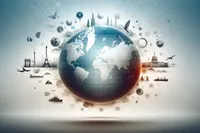Atomic scientists keep 'Doomsday Clock' as close to midnight as ever
Atomic scientists cite nuclear weapons, climate change, and disruptive technologies as factors driving the risk of global catastrophe.

Scientists Keep 'Doomsday Clock' Close to Midnight
Atomic scientists have decided to keep their "Doomsday Clock" set as close to midnight as ever before. This decision comes in response to several factors, including Russia's actions on nuclear weapons during its invasion of Ukraine, nuclear-armed Israel's Gaza war, and worsening climate change. The 'Doomsday Clock' represents the theoretical point of annihilation.
The Bulletin of the Atomic Scientists, who are responsible for setting the clock, kept it at 90 seconds to midnight, the same position as last year. The clock is set based on existential risks to Earth and its people, such as nuclear threats, climate change, and disruptive technologies like artificial intelligence and biotechnology.
Rachel Bronson, the president and CEO of the Bulletin, emphasized that the decision to keep the clock unchanged does not suggest stability in the world. Conflict hotspots globally, the impacts of climate change, and the advancement of potentially dangerous technologies all contribute to the ongoing risk of catastrophe.
Ominous Trends Point Toward Catastrophe
The 'Doomsday Clock' was created by the Chicago-based nonprofit, the Bulletin of the Atomic Scientists, in 1947 to warn the public about the potential destruction of the world. It was established during the Cold War tensions following World War Two. The Bulletin warned that current trends continue to point toward catastrophe. China, Russia, and the United States are all investing heavily in expanding or modernizing their nuclear arsenals, increasing the risk of nuclear war due to error or miscalculation.
The large-scale invasion of Ukraine by Russia, which will reach its second anniversary next month, has significantly escalated tensions with the West. A durable end to the conflict seems unlikely, and there is a serious possibility that Russia may use nuclear weapons in the region. Russia's decision to suspend its participation in the New START treaty with the United States, as well as other concerning nuclear signals, have added to the risks.
According to Alexander Glaser of Princeton University, a member of the Bulletin's board of experts, traditional nuclear arms control has come to an end. Meanwhile, China, Russia, and the United States are engaged in a three-way nuclear arms race, further worsening the situation.
Israel's Actions and Climate Change
Israel's actions as a nuclear state are also a cause for concern. The ongoing conflict with Hamas in Gaza has the potential to escalate into a larger conventional war involving more nuclear powers or near-nuclear powers in the region. This creates additional risks to global security.
Climate change is another major factor considered in setting the 'Doomsday Clock.' The year 2023 experienced record-breaking temperatures and rising greenhouse gas emissions. Both global and North Atlantic sea-surface temperatures reached unprecedented levels, while Antarctic sea ice reached its lowest daily extent on record. Although clean energy saw significant investments, fossil fuel investments remained high. Efforts to reduce greenhouse gas emissions are considered insufficient to avoid dangerous impacts from climate change, particularly for the world's poorest populations.



